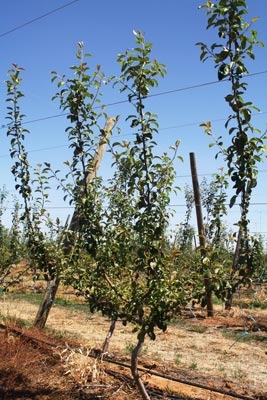Open Tatura with four leaders
For an Open Tatura with four leaders (multi-leader trees), a planting density of 2222 trees per hectare is affordable.
With four leaders per tree and two leaders on each side of the trunk, there are 500 millimetres between leaders. On the other hand, the canopy develops more slowly with fewer trees per hectare and six leaders per tree, because it takes more time, care and leader-bending than with four leaders.
Pitfall in the early development
There is one pitfall in the early development of the four leaders. The inner two shoots tend to be more vigorous than the outer two shoots (see Figure 5).
The orchardist needs to subdue (cut back to a short stub) the two inner shoots, to give the two outer shoots a good head start.
At the end of the first growing season, the two inner shoots have usually caught up with the growth of the two outer shoots (see Figure 4 and August 2014 Tree Fruit).
Some countries and regions specialise in apples because different types of spindle trees on low-vigour rootstocks appear to produce profitable apples.
However, in countries like Australia, many orchardists grow different cultivars of both stone and pome fruit, and use various systems for training trees. Some systems continue to evolve to suit different fruit species and conditions.
The branchless multi-leader tree, for example, can be used for both angled and vertical trees and can maintain optimum and affordable tree density. Trees are managed simply, vigour is controlled without size-controlling rootstocks, yet yield and pack-outs of fruit of high quality are increased.
For information, see Tree Fruit October 2014






















